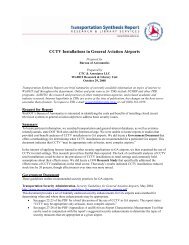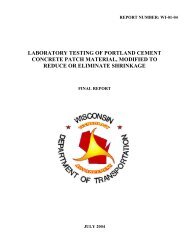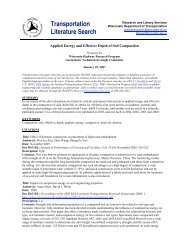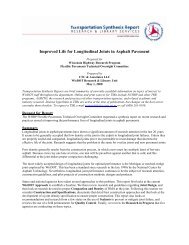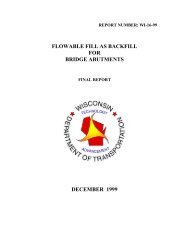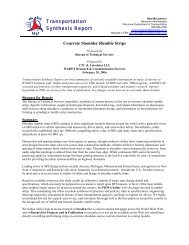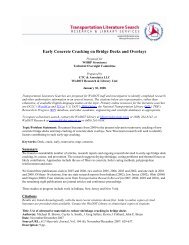Limitations of the Use of Abrasives in Winter ... - Clear Roads
Limitations of the Use of Abrasives in Winter ... - Clear Roads
Limitations of the Use of Abrasives in Winter ... - Clear Roads
Create successful ePaper yourself
Turn your PDF publications into a flip-book with our unique Google optimized e-Paper software.
<strong>Limitations</strong> <strong>of</strong> <strong>the</strong> <strong>Use</strong> <strong>of</strong> <strong>Abrasives</strong> <strong>in</strong> W<strong>in</strong>ter Ma<strong>in</strong>tenance Operations<br />
Prepared for<br />
Bureau <strong>of</strong> Highway Operations<br />
Prepared by<br />
CTC & Associates LLC<br />
WisDOT Research & Library Unit<br />
December 30, 2008<br />
Transportation Syn<strong>the</strong>sis Reports are brief summaries <strong>of</strong> currently available <strong>in</strong>formation on topics <strong>of</strong> <strong>in</strong>terest to<br />
WisDOT staff throughout <strong>the</strong> department. Onl<strong>in</strong>e and pr<strong>in</strong>t sources for TSRs <strong>in</strong>clude NCHRP and o<strong>the</strong>r TRB<br />
programs, AASHTO, <strong>the</strong> research and practices <strong>of</strong> o<strong>the</strong>r transportation agencies, and related academic and<br />
<strong>in</strong>dustry research. Internet hyperl<strong>in</strong>ks <strong>in</strong> TSRs are active at <strong>the</strong> time <strong>of</strong> publication, but changes on <strong>the</strong> host server<br />
can make <strong>the</strong>m obsolete. To request a TSR, e-mail research@dot.state.wi.us or call (608) 261-8198.<br />
Request for Report<br />
In <strong>the</strong> <strong>in</strong>terest <strong>of</strong> develop<strong>in</strong>g more effective w<strong>in</strong>ter ma<strong>in</strong>tenance operat<strong>in</strong>g procedures, WisDOT’s Bureau <strong>of</strong><br />
Highway Operations is <strong>in</strong>terested <strong>in</strong> know<strong>in</strong>g more about <strong>the</strong> limitations <strong>of</strong> <strong>the</strong> use <strong>of</strong> sand <strong>in</strong> w<strong>in</strong>ter ma<strong>in</strong>tenance<br />
operations. As <strong>the</strong> lead state for <strong>the</strong> <strong>Clear</strong> <strong>Roads</strong> w<strong>in</strong>ter ma<strong>in</strong>tenance pooled fund, WisDOT will share <strong>the</strong> results <strong>of</strong><br />
this research with <strong>the</strong> <strong>Clear</strong> <strong>Roads</strong> member states.<br />
Summary<br />
While sand, <strong>the</strong> most common abrasive used <strong>in</strong> w<strong>in</strong>ter ma<strong>in</strong>tenance, cannot melt snow and ice, it does play a role <strong>in</strong><br />
many w<strong>in</strong>ter ma<strong>in</strong>tenance programs. Accord<strong>in</strong>g to NCHRP Report 526, Snow and Ice Control: Guidel<strong>in</strong>es for<br />
Materials and Methods, “<strong>the</strong> primary function <strong>of</strong> abrasives is to provide temporary traction (friction) improvement<br />
on snow/ice surfaces.” Many agencies use sand to ma<strong>in</strong>ta<strong>in</strong> safety at hills, curves, <strong>in</strong>tersections and low-volume<br />
roads, and on packed snow or ice that is too thick for chemicals to penetrate. We summarize WisDOT’s Current<br />
Practice <strong>in</strong> <strong>the</strong> use <strong>of</strong> abrasives <strong>in</strong> w<strong>in</strong>ter ma<strong>in</strong>tenance below.<br />
Sand’s use over time has decl<strong>in</strong>ed due to a variety <strong>of</strong> Limit<strong>in</strong>g Factors, <strong>in</strong>clud<strong>in</strong>g its Effectiveness, Environmental<br />
Impacts, Safety Implications and Cost. See below for f<strong>in</strong>d<strong>in</strong>gs from reports and studies that address <strong>the</strong> limitations<br />
<strong>of</strong> <strong>the</strong> use <strong>of</strong> sand <strong>in</strong> w<strong>in</strong>ter ma<strong>in</strong>tenance operations. We conclude with Recommended Best Practices for <strong>the</strong> use <strong>of</strong><br />
abrasives <strong>in</strong> w<strong>in</strong>ter ma<strong>in</strong>tenance programs compiled from two 2001 documents.<br />
WisDOT’s Current Practice<br />
Chapter 35 <strong>of</strong> <strong>the</strong> State Highway Ma<strong>in</strong>tenance Manual provides recommendations for <strong>the</strong> use <strong>of</strong> abrasives <strong>in</strong> w<strong>in</strong>ter<br />
operations. Sand and o<strong>the</strong>r locally available abrasive materials can be used when high w<strong>in</strong>ds or storm conditions<br />
preclude <strong>the</strong> use <strong>of</strong> salt, or when pavement temperatures are too low (10°F or less) for deic<strong>in</strong>g agents to work<br />
effectively. When conditions warrant, abrasives may be applied to predeterm<strong>in</strong>ed low-speed areas such as certa<strong>in</strong><br />
grades, curves, <strong>in</strong>tersections, structures and isolated areas where hazards exist. <strong>Abrasives</strong> should not be used where<br />
vehicle speeds exceed 45 mph. Prewett<strong>in</strong>g <strong>of</strong> abrasives with a deic<strong>in</strong>g agent is recommended to improve adherence<br />
to <strong>the</strong> roadway. Contact <strong>the</strong> WisDOT Library at library@dot.state.wi.us for a copy <strong>of</strong> WisDOT’s State Highway<br />
Ma<strong>in</strong>tenance Manual.<br />
Limit<strong>in</strong>g Factors<br />
Effectiveness<br />
Sand has exhibited limited effectiveness at higher vehicle speeds, especially when it has not been prewetted. Mix<strong>in</strong>g<br />
sand with salt to keep it from freez<strong>in</strong>g also limits sand’s effectiveness.
• Studies suggest that at highway speeds sand is swept <strong>of</strong>f <strong>the</strong> road after relatively few vehicle passes (eight<br />
to 12) and that friction ga<strong>in</strong>s from sand<strong>in</strong>g (when <strong>the</strong> sand rema<strong>in</strong>s on <strong>the</strong> road) are m<strong>in</strong>imal (Nixon 2001b,<br />
page 1).<br />
• Snow- and ice-covered roadways that have been treated with abrasives provide friction values that are far<br />
less than “bare” or “wet” pavement (NCHRP, page 25).<br />
• Dur<strong>in</strong>g storm periods when anti-ic<strong>in</strong>g operations are successful, abrasive applications provide no consistent<br />
or apparent benefit <strong>in</strong> hard-brak<strong>in</strong>g friction, traction or pavement condition (FHWA 1998, page 208 <strong>of</strong> <strong>the</strong><br />
PDF).<br />
• Mix<strong>in</strong>g sand with 50 to 100 pounds <strong>of</strong> salt per cubic yard is necessary to prevent freez<strong>in</strong>g and keep it<br />
workable (Wiscons<strong>in</strong> Transportation Center, page 4).<br />
• A mix <strong>of</strong> abrasives and chemical will usually be no more effective as an anti-ic<strong>in</strong>g treatment dur<strong>in</strong>g<br />
snowstorms than <strong>the</strong> same amount <strong>of</strong> chemical placed alone (FHWA 1996b; click on 2.5 <strong>Abrasives</strong> <strong>Use</strong>).<br />
• A 1973 study (Keyser, pages 4-6 <strong>of</strong> <strong>the</strong> Word file) <strong>in</strong>dicates that <strong>the</strong> melt<strong>in</strong>g <strong>of</strong> snow and ice will be<br />
delayed by us<strong>in</strong>g a mixture <strong>of</strong> salt and sand.<br />
• In a blend, sand and salt <strong>of</strong>ten work aga<strong>in</strong>st each o<strong>the</strong>r. The salt <strong>in</strong> <strong>the</strong> mix may blow away as vehicles<br />
travel <strong>the</strong> roadway. If <strong>the</strong> sand rema<strong>in</strong>s on snow, tires can push <strong>the</strong> sand down <strong>in</strong>to <strong>the</strong> slush, mak<strong>in</strong>g it<br />
<strong>in</strong>effective for improv<strong>in</strong>g traction. Also, salt melts less ice when mixed with sand (Wiscons<strong>in</strong><br />
Transportation Center, page 4).<br />
• <strong>Use</strong> <strong>of</strong> salt/abrasives mixes at moderately or much higher application rates than straight chemical does not<br />
lead to correspond<strong>in</strong>g improvements <strong>in</strong> hard-brak<strong>in</strong>g friction or pavement conditions. Comparisons <strong>of</strong> test<br />
and control operations us<strong>in</strong>g identical salt/abrasives mixes show that more frequent applications at similar<br />
rates also do not lead to correspond<strong>in</strong>g improvements <strong>in</strong> friction or pavement conditions and even <strong>in</strong>dicate<br />
that <strong>the</strong> more frequent applications can lead to slightly worse conditions (FHWA 1998, Section 7.4.1 on<br />
page 208 <strong>of</strong> <strong>the</strong> PDF).<br />
Environmental Impacts<br />
Studies have shown that sand rema<strong>in</strong>s <strong>in</strong> <strong>the</strong> environment after its application, result<strong>in</strong>g <strong>in</strong> negative impacts on land,<br />
water and health.<br />
• An Oregon DOT study <strong>in</strong> <strong>the</strong> early 1990s found that 50 to 90 percent <strong>of</strong> sand applied to pavements rema<strong>in</strong>s<br />
<strong>in</strong> <strong>the</strong> environment after cleanup (FHWA 1996c).<br />
• Up to 70 percent <strong>of</strong> sand enter<strong>in</strong>g Lake Tahoe was shown to be from snow and ice control. Sand was be<strong>in</strong>g<br />
carried by snowmelt <strong>in</strong>to culverts that dra<strong>in</strong>ed <strong>in</strong>to <strong>the</strong> lake (FHWA 1996a).<br />
• Sand creates debris deposits on roadways, mix<strong>in</strong>g with oil, grease and o<strong>the</strong>r automotive byproducts. Sand<br />
rema<strong>in</strong><strong>in</strong>g on roadways clogs storm water catch bas<strong>in</strong>s and fills streambeds, cloud<strong>in</strong>g <strong>the</strong> water, hurt<strong>in</strong>g<br />
aquatic animals and lead<strong>in</strong>g to an <strong>in</strong>crease <strong>in</strong> microorganisms. If collected at <strong>the</strong> end <strong>of</strong> w<strong>in</strong>ter<br />
ma<strong>in</strong>tenance, sand may have to be disposed <strong>of</strong> as a hazardous waste. Sand is also ground <strong>in</strong>to a f<strong>in</strong>e dust by<br />
traffic, which can trigger respiratory problems like asthma (EPA).<br />
• The use <strong>of</strong> abrasives can contribute to <strong>in</strong>creased levels <strong>of</strong> ambient PM 10 , <strong>the</strong> very small airborne particulate<br />
matter that is <strong>in</strong>haled <strong>in</strong>to <strong>the</strong> lungs and can cause respiratory problems. Researchers found that <strong>the</strong> use <strong>of</strong><br />
abrasives <strong>in</strong>creased <strong>the</strong> rate <strong>of</strong> road dust re-entra<strong>in</strong>ment. Street sweep<strong>in</strong>g, a practice <strong>in</strong>tended to m<strong>in</strong>imize<br />
air quality impacts <strong>of</strong> roadway abrasives, was found to actually <strong>in</strong>crease <strong>the</strong> observed emission rate<br />
(Gertler, page 5984).<br />
• Uncovered sand piles mixed with salt are susceptible to leach<strong>in</strong>g. One study <strong>in</strong>dicated that 10 <strong>in</strong>ches <strong>of</strong><br />
precipitation leached out 50 percent <strong>of</strong> <strong>the</strong> salt (Walker, page 2).<br />
2
Safety Implications<br />
Some research has concluded that sand used <strong>in</strong> a salt-abrasive mixture does not contribute to accident reductions.<br />
• Accident rate reductions on two-lane highways were less with salt-abrasive mixtures than with salt only.<br />
Accident rates dropped dramatically after achievement <strong>of</strong> bare pavement with salt only but more slowly<br />
with salt-abrasive mixes. Accident reductions for freeways were much less and took much longer to occur<br />
when salt-abrasive mixtures were used, as compared with <strong>the</strong> use <strong>of</strong> salt only (Kuemmel and Bari, page 9<br />
<strong>of</strong> <strong>the</strong> PDF).<br />
Cost<br />
Research <strong>in</strong>dicates that salt is more cost-effective than sand <strong>in</strong> w<strong>in</strong>ter ma<strong>in</strong>tenance operations.<br />
• <strong>Abrasives</strong> must be used <strong>in</strong> large quantities and applied frequently, mak<strong>in</strong>g abrasives more expensive than<br />
salt <strong>in</strong> terms <strong>of</strong> material and manpower (Salt Institute 2004, page 8).<br />
• When mixed with enough ice control chemical, abrasives will support anti-ic<strong>in</strong>g and deic<strong>in</strong>g strategies;<br />
however, this is very <strong>in</strong>efficient and costly, as <strong>the</strong> abrasives for <strong>the</strong> most part are “go<strong>in</strong>g along for <strong>the</strong> ride”<br />
while <strong>the</strong> chemical portion <strong>of</strong> <strong>the</strong> mix is do<strong>in</strong>g <strong>the</strong> work (NCHRP, page 14).<br />
• A loaded salt truck, spread<strong>in</strong>g at <strong>the</strong> rate <strong>of</strong> 500 pounds per two-lane mile for general storm conditions, can<br />
treat a 22.5-mile stretch <strong>of</strong> roadway, travel<strong>in</strong>g a total <strong>of</strong> 45 miles. A sand truck requires seven loads, must<br />
travel a distance <strong>of</strong> 187 miles to treat <strong>the</strong> same section <strong>of</strong> road, and requires four times more fuel (Salt<br />
Institute 1995, page 3).<br />
• Benefit-cost calculations showed that <strong>the</strong> application <strong>of</strong> salt-abrasive mixtures did not recover w<strong>in</strong>ter<br />
ma<strong>in</strong>tenance costs on two-lane highways dur<strong>in</strong>g <strong>the</strong> 12-hour analysis period. Benefit-cost calculations<br />
showed that freeway operations recovered costs <strong>in</strong> six hours, substantially longer than <strong>the</strong> 35 m<strong>in</strong>utes with<br />
salt only (Kuemmel and Bari, page 11 <strong>of</strong> <strong>the</strong> PDF).<br />
• Cost analyses <strong>in</strong>dicate that, where cleanup is performed, <strong>the</strong> most significant reduction <strong>in</strong> operational costs<br />
will result from <strong>the</strong> elim<strong>in</strong>ation <strong>of</strong> <strong>the</strong> use <strong>of</strong> abrasives as an anti-ic<strong>in</strong>g treatment (FHWA 1998, page 208 <strong>of</strong><br />
<strong>the</strong> PDF).<br />
• The cost for distribut<strong>in</strong>g abrasives on roads is several times higher than those for distribution <strong>of</strong> salt. Tests<br />
carried out on selected road sections <strong>in</strong> Zurich and Chur, Switzerland, <strong>in</strong>dicate that <strong>in</strong> a normal w<strong>in</strong>ter, <strong>the</strong><br />
costs for distribut<strong>in</strong>g abrasives over a 1-kilometer section are approximately six times higher than those for<br />
distribut<strong>in</strong>g salt. In a severe w<strong>in</strong>ter this factor rose to as high as 10 (Schlup and Ruess, page 49).<br />
• W<strong>in</strong>dshield damage from airborne particulates is 365 percent higher <strong>in</strong> areas us<strong>in</strong>g sand and abrasives<br />
<strong>in</strong>stead <strong>of</strong> salt (Salt Institute 2004, page 9).<br />
Recommended Best Practices<br />
Two 2001 reports published by Wilfrid Nixon provide recommendations for <strong>the</strong> use <strong>of</strong> abrasives based on road type.<br />
The first report <strong>of</strong>fers general recommendations for <strong>the</strong> use <strong>of</strong> dry abrasives (see pages 20-22 <strong>of</strong> <strong>the</strong> PDF). The<br />
second report expands on those recommendations to consider three different abrasive types: dry abrasives, abrasives<br />
prewetted with liquid deicers at <strong>the</strong> spreader or tailgate, and abrasives applied us<strong>in</strong>g a hot method (see pages 44-45).<br />
Examples <strong>of</strong> hot methods <strong>in</strong>clude heat<strong>in</strong>g abrasives to high temperatures (approximately 180°C) just before<br />
application and mix<strong>in</strong>g <strong>the</strong> abrasives with hot water (about 90°C) as <strong>the</strong>y are placed on <strong>the</strong> road. Nixon considers <strong>the</strong><br />
hot application methods experimental, though promis<strong>in</strong>g. Nixon’s guidel<strong>in</strong>es for abrasive use <strong>in</strong>clude:<br />
Rural <strong>Roads</strong>. Rural roads can see high-speed traffic. For this reason, if elect<strong>in</strong>g to apply dry abrasives, limit<br />
application to hills and curves on low-speed, low-volume roads. Application <strong>of</strong> prewetted abrasives on paved roads<br />
allows <strong>the</strong> abrasives to stay on <strong>the</strong> roadway longer than if <strong>the</strong> abrasives had been applied dry. Prewetted abrasives<br />
can also melt <strong>the</strong> snowpack and provide for extended <strong>in</strong>crease <strong>in</strong> road surface friction.<br />
Rural Intersections. Given <strong>the</strong> low speeds associated with rural <strong>in</strong>tersections, abrasives could be applied dry.<br />
However, if <strong>the</strong> <strong>in</strong>tersection is not gravel, prewett<strong>in</strong>g <strong>the</strong> abrasive will allow <strong>the</strong> treatment to rema<strong>in</strong> <strong>in</strong> place longer.<br />
3
High-Speed Urban <strong>Roads</strong>. No benefit is expected when apply<strong>in</strong>g dry abrasives to <strong>the</strong>se roads where posted speed<br />
limits exceed 30 mph. Application <strong>of</strong> prewetted abrasives may be appropriate for this road type; hot abrasives may<br />
also be considered.<br />
Low-Speed Urban <strong>Roads</strong>. Limit dry abrasive application to <strong>the</strong> parts <strong>of</strong> <strong>the</strong> road where brak<strong>in</strong>g, accelerat<strong>in</strong>g or<br />
maneuver<strong>in</strong>g is done, and only use this approach when <strong>the</strong> snowpack is expected to persist. Application <strong>of</strong> prewetted<br />
abrasives will allow <strong>the</strong> material to rema<strong>in</strong> on <strong>the</strong> road surface longer. Aga<strong>in</strong>, hot application methods may be<br />
appropriate.<br />
Urban Intersections. Dry abrasives can be used where <strong>the</strong> <strong>in</strong>tersection is likely to be snow- or ice-covered for a<br />
longer-than-normal period <strong>of</strong> time. Prewetted abrasives will rema<strong>in</strong> <strong>in</strong> place longer; hot application methods might<br />
also be considered.<br />
References<br />
EPA. 2005. “What You Should Know About Safe W<strong>in</strong>ter <strong>Roads</strong> and <strong>the</strong> Environment,” EPA 901-F-05-020.<br />
http://www.epa.gov/region1/topics/water/pdfs/w<strong>in</strong>terfacts.pdf<br />
FHWA. 1996a. “Anti-ic<strong>in</strong>g Strategies Improve Safety and Protect <strong>the</strong> Environment,” Focus, May 1996.<br />
http://www.tfhrc.gov/focus/archives/56nevada.htm<br />
FHWA. 1996b. Manual <strong>of</strong> Practice for an Effective Anti-ic<strong>in</strong>g Program: A Guide for Highway W<strong>in</strong>ter Ma<strong>in</strong>tenance<br />
Personnel.<br />
http://www.fhwa.dot.gov/reports/mopeap/mop0296a.htm<br />
FHWA. 1996c. “Sav<strong>in</strong>g Money and <strong>the</strong> Environment,” Publication No. FHWA-SA-96-045 (CS092).<br />
http://ops.fhwa.dot.gov/wea<strong>the</strong>r/resources/publications/tech_briefs/cs092.htm<br />
FHWA. 1998. Test and Evaluation Project No. 28: Anti-ic<strong>in</strong>g Technology, Field Evaluation Report, Publication No.<br />
FHWA-RD-97-132.<br />
http://ntl.bts.gov/lib/5000/5700/5786/132.pdf<br />
Gertler, A., et al. 2006. “A Case Study <strong>of</strong> <strong>the</strong> Impact <strong>of</strong> W<strong>in</strong>ter Road Sand/Salt and Street Sweep<strong>in</strong>g on Road Dust<br />
Re-entra<strong>in</strong>ment,” Atmospheric Environment 40, 5976-5985.<br />
Keyser, J.H. 1973. “De-ic<strong>in</strong>g Chemicals and <strong>Abrasives</strong>: State <strong>of</strong> <strong>the</strong> Art,” Highway Research Record 425, 36-51.<br />
http://www.clearpathicemelt.net/docs/DE-<br />
ICING%20CHEMICALS%20AND%20ABRASIVES%20STATE%20OF%20THE%20ART.doc<br />
Kuemmel, D.A., and Q. Bari. 1996. “Benefit-Cost Comparison <strong>of</strong> Salt-Only Versus Salt-Abrasive Mixtures <strong>Use</strong>d<br />
<strong>in</strong> W<strong>in</strong>ter Highway Ma<strong>in</strong>tenance <strong>in</strong> <strong>the</strong> United States.” In Snow Removal and Ice Control Technology, Selected<br />
Papers Presented at <strong>the</strong> Fourth International Symposium, Reno, Nevada, August 11-16, 1996.<br />
http://www.salt<strong>in</strong>stitute.org/marquette2-full.pdf<br />
NCHRP. 2004. Report 526: Snow and Ice Control: Guidel<strong>in</strong>es for Materials and Methods.<br />
http://onl<strong>in</strong>epubs.trb.org/Onl<strong>in</strong>epubs/nchrp/nchrp_rpt_526.pdf<br />
Nixon, W.A. 2001a. The <strong>Use</strong> <strong>of</strong> <strong>Abrasives</strong> <strong>in</strong> W<strong>in</strong>ter Ma<strong>in</strong>tenance: F<strong>in</strong>al Report <strong>of</strong> Project TR 434, Iowa DOT.<br />
http://www.iihr.uiowa.edu/products/pubvid/pdf/IIHR416.pdf<br />
Nixon, W.A. 2001b. “<strong>Use</strong> <strong>of</strong> <strong>Abrasives</strong> <strong>in</strong> W<strong>in</strong>ter Ma<strong>in</strong>tenance at <strong>the</strong> County Level,” Transportation Research<br />
Record 1741.<br />
See abstract at http://pubs<strong>in</strong>dex.trb.org/document/view/default.asp?lbid=688956.<br />
Salt Institute. 1995. “Deic<strong>in</strong>g Salt Facts: A Quick Reference.”<br />
http://www.salt<strong>in</strong>stitute.org/snowfight<strong>in</strong>g/deic<strong>in</strong>gsaltfacts.zip<br />
Salt Institute. 2004. Highway Salt and Our Environment.<br />
http://www.salt<strong>in</strong>stitute.org/publications/saltandenvironment-english.pdf<br />
4
Schlup, U., and B. Ruess. 2001. “<strong>Abrasives</strong> and Salt: New Research on Their Impact on Security, Economy and <strong>the</strong><br />
Environment,” Transportation Research Record 1741.<br />
See abstract at http://pubs<strong>in</strong>dex.trb.org/document/view/multi.asp?pub=1&recordlist=688957|.<br />
Walker, D. 2005. “The Truth about Sand and Salt for W<strong>in</strong>ter Ma<strong>in</strong>tenance,” Salt and Highway Deic<strong>in</strong>g, Vol. 42,<br />
No. 2, 1-4.<br />
http://www.salt<strong>in</strong>stitute.org/publications/shd/shd-june-2005.pdf<br />
Wiscons<strong>in</strong> Transportation Center. 2005. Wiscons<strong>in</strong> Transportation Bullet<strong>in</strong> No. 6: “Us<strong>in</strong>g Salt and Sand for<br />
W<strong>in</strong>ter Road Ma<strong>in</strong>tenance.”<br />
http://epdfiles.engr.wisc.edu/pdf_web_files/tic/bullet<strong>in</strong>s/Bltn_006_SaltNSand.pdf<br />
5



